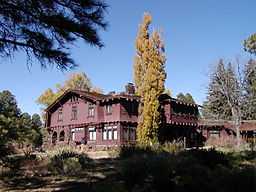Charles Frederick Whittlesey


Charles Frederick Whittlesey (1867–1941) was an American architect best known for his work in the American southwest, and for pioneering work in reinforced concrete in California.
Life
Born in Alton, Illinois, Whittlesey was a draftsman for Louis Sullivan before opening his own Chicago practice.[1] Many of Whittlesey's major commissions show Sullivan's influence.
In 1900, at the age of 33, Whittlesey was appointed Chief Architect for the Atchison, Topeka, and Santa Fe Railway. Among many other stations and hotels for the railroad, he designed the El Tovar Hotel, the former Harvey House situated just 20 ft from the south rim of the Grand Canyon in Arizona, USA. It stands at the northern terminus of the Grand Canyon Railway, formerly a branch of the Santa Fe. The hotel is one of only a handful of Harvey House facilities still in operation, and is an example of National Park Service Rustic architecture. The razed Alvarado Hotel in Albuquerque, New Mexico was also his design, with interior work done by Mary Colter.
Whittlesey moved to San Francisco in 1907 and worked mainly there and in Los Angeles, becoming known for his early work in reinforced concrete. His son Austin Whittlesey was also an architect, apprenticed in the office of Bertram Goodhue for seven years, and was active in Southern California in the 1930s. While working as staff designer for Allison & Allison he designed the 1930 Southern California Edison Building, across the street from Goodhue's L.A. Public Library.
Work
- the Alvarado Hotel, Albuquerque, New Mexico, 1902,[2] with the interior by Mary Colter [3] (razed)
- Whittlesey House, Albuquerque, New Mexico, 1903[4] (now known as the Albuquerque Press Club)[5]
- Sante Fe Railroad Depot, Berkeley, California, 1903
- the Riordan family homes, now the Riordan Mansion State Historic Park, in Flagstaff, Arizona, 1904
- the George Babbitt home, 1904 Flagstaff, Arizona (burned down circa 1960)
- Hotel Hayward, Los Angeles, 1905
- El Tovar Hotel, Grand Canyon, Arizona, 1905. "The most expensively constructed pointed log house in America." [6]
- Clune's Auditorium, Los Angeles, 1905–06, billed as the largest reinforced concrete structure in California,[7] later redubbed the Philharmonic Auditorium. The auditorium "exhibited some of the most enthusiastic Sullivanesque ornament to be found in Southern California."[8] This Moorish Revival building, described as "one of the most beautiful buildings in Los Angeles" was demolished in 1985. The site is now (2012) a parking lot.[9]
- Hotel Wentworth, Pasadena, California, 1907, later purchased by Henry E. Huntington, reworked by Myron Hunt, and reopened as the Huntington Hotel in 1914. In 1954 the hotel complex was sold to the Sheraton Hotel chain.[10]
- Pacific Building, San Francisco, 1907, "remarkable for its Sullivanesque terra cotta ornament",[11] now the Palomar Hotel
- Lycurgus Lindsay House, Los Angeles, 1908
- Hueter Building, 816 Mission Street, San Francisco, 1908 [12]
- Apartment building, 1230-38 Taylor Street, San Francisco, 1909,[13]
- seven historic houses in the Russian Hill District, San Francisco, 1910-1913[14]
- Old Student Union, Stanford, Stanford, California, 1915 [15]
- El Rey Hotel, Los Angeles, 1923
- the Moorish-influenced Mayflower Hotel, Los Angeles, 1927
References
- ↑ https://digital.lib.washington.edu/architect/architects/102/
- ↑ Poling-Kempes, Lesley, The Harvey Girls Marlowe and Company, New York, 1989 p. 157
- ↑ Berke, Arnold, Mary Coulter: Architect of the Southwest, Princeton Architectural Press, New York, 2002 p, 55
- ↑ http://www.cabq.gov/planning/lucc/whittlesey.html
- ↑ http://www.qpressclub.com/main/whpf
- ↑
- El Tovar Hotel, 167-168
- ↑ https://digital.lib.washington.edu/architect/structures/129/
- ↑ Gebhard and Winter, A Guide to Architecture in Los Angeles & Southern California, Peregrine Press Inc., Santa Barbara, CA, 1977, p. 211
- ↑ McGrew and Julian, Landmarks of Los Angeles, Harry N. Abrams, Inc., NY, 1994 p. 65
- ↑ Moore, Becker and Campbell, The City Observed: Los Angeles, Vintage Books, New York, 1984, P336-337
- ↑ Gebhard and Winter, ‘’A Guide to Architecture in San Francisco and Northern California’’, Peregrine Smith Books, Salt Lake City, UT, 1985 p. 80
- ↑ Corbet, Michael, "Splendid Survivors: San Francisco's Downtown Architectural Heritage", The Foundation for San Francisco's Architectural Heritage, San Francisco, CA 1979 p. 222
- ↑ Woodbridge, Sally B. and John M. Woodbridge, ‘’’Architecture’ San Francisco, the guide’’, American Institute of Architects, San Francisco Chapter, San Francisco, CA, 1982 p. 58-59
- ↑ http://www.rhn.org/historysummitIwalk.html
- ↑ Gebhard and Winter, ‘’A Guide to Architecture in San Francisco and Northern California’’, Peregrine Smith Books, Salt Lake City, UT, 1985 p, 162
|